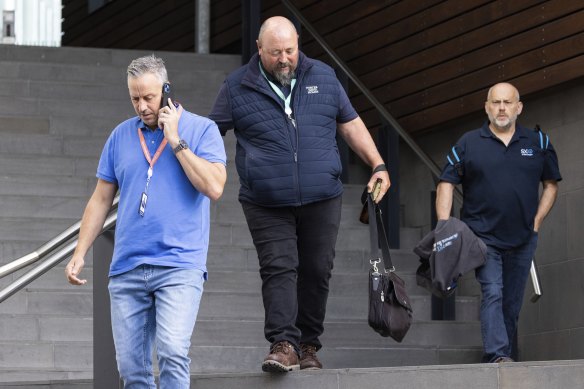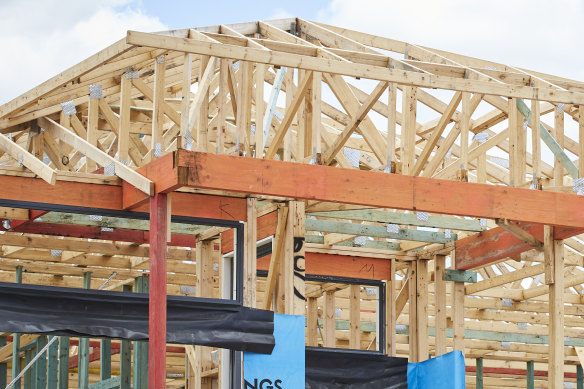This was published 2 years ago
Building industry ‘on the brink’ after two groups collapse in 24 hours
By Sarah Danckert, Simon Johanson, Najma Sambul, Josh Gordon and Rachel Clun
Australia’s construction industry is reeling after one of the nation’s largest home builders and a prominent civil construction group collapsed on the same day, sparking warnings that more groups will go to the wall as costs increases bite and demand weakens.
The collapse of Melbourne-based Porter Davis, the country’s 12th largest home builder, immediately stopped work on Friday on the 1500 homes it had under way in Victoria – and another 200 in Queensland – after it was unable to find a last-minute buyer or financial backer to cover a funding shortfall estimated at as much as $20 million.
A further 779 customers who had signed a contract and paid a deposit are also affected, while 410 staff were also made redundant on Friday morning after liquidators were appointed. The liquidation does not include Porter Davis’ Englehart homes business.
Lloyds Group also appointed administrators on Friday after collapsing under increasing cost pressures. The company – which has built many schools – employs 200 staff and has 59 projects under way across Victoria and NSW.
The collapsed companies join a growing list of major builders suffering from rising cost of products and labour, as well as less funding appetite from banks and investors and a slowing market.
Several industry sources, speaking anonymously to discuss confidential financial matters, suggested that at least three other well-known home builders were struggling to stay afloat.

Workers leave the Porter Davis office in Melbourne on Friday morning.Credit: Paul Jeffers
Australia’s largest home builder Metricon narrowly avoided administration last year after it put together a rescue package with the support of shareholders, following the sudden death of its founder.
Grant Thornton partner Matt Byrnes, who has been appointed as a liquidator to Porter Davis, said the problems with the construction industry had been looming for some time.
“There’s a number of headwinds that have confronted construction more broadly – rising input costs; difficulties in accessing labor and access to finance has tightened,” Byrnes said.
“We’ve seen that over the last six or nine months it’s more difficult for Australian businesses to access funding, whether it’s through capital or through debt.”
KordaMentha senior partner Craig Shepard, who worked on Grocon’s collapse, said the construction industry was on the brink of a crisis.
“It’s the contagion impact that people should be worried about following today’s appointment of liquidators to Porter Davis. There’s a number of other participants in the volume home building sector that are in a similar position and might be in trouble in the coming months,” he said.
Data and analytics firm Equifax said construction insolvencies have grown by 90 per cent over the financial year to date, part of a downward trend playing out across the sector. About a third of construction companies Equifax assesses were downgraded in January.
Many issues are bringing building and construction firms to the brink said Kristen Beadle, manager of insolvency policy at professional accounting body CPA Australia. Without commenting on the Porter Davis collapse specifically, she said to expect further insolvencies in the coming months.

A man and woman hug outside Porter Davis’ Melbourne office on Friday.Credit: Paul Jeffers
“It is a big issue for a lot of them because what we’ve been told is that they traditionally sort of use that next project to help finish the project before,” Beadle said.
“You need that that sort of pipeline work to keep you going. If that pipeline works, not there it is, it is going to affect them.”
Both the Housing Industry Association and Master Builders Australia moved to reassure consumers, with the MBA describing the rate of collapses as being in line with the rate over the past 10 years and the HIA chief economist Tim Reardon saying the industry was at the tail end of a tough economic cycle.
“There is fragility and volatility in the industry at the moment,” MBA chief executive Denita Wawn said, pointing to a squeeze from fixed price contracts and rising costs from inflation and interest rates.
The Victorian government urged customers caught in the Porter Davis collapse to contact the Victorian Managed Insurance Agency (VMIA) about access to domestic building insurance.
Domestic building insurance must be taken out by a builder where the contract price for the job is more than $16,000 and is designed to protect homeowners for defective or unfinished work if their builder becomes insolvent. Customers can claim up to 20 per cent of their contract price under their insurance up to a value of $300,000.
“Mandatory protections are in place for people engaging residential builders and we urge clients to contact the VMIA to discuss their policies,” a spokesman for Treasurer Tim Pallas said.
“We understand the pressure on builders due to labour and supply chain issues and continue to consult with the industry.”

Porter Davis has more than 1500 homes in progress in Victoria and a further 200 homes in Queensland.Credit: Natalie Boog
The VMIA said the Porter Davis’ liquidator was in urgent talks to work out whether there was any potential for another builder to take over current contracts and ongoing builds.
Federal opposition housing spokesman Michael Sukkar said the former Coalition government had worked closely with the home building industry to help it through the dark days of the pandemic, but the federal Labor government was missing in the face of the current problems.
“The Labor government has had no plan to support the residential construction industry during these difficult times, putting businesses and livelihoods at risk,” he said.
A spokesperson for the federal government said Porter Davis’ collapse was concerning.
“We are seeking an update from the state government on the situation,” they said in a statement.
Porter Davis Homes appointed liquidators from Grant Thornton after its search for extra funding or a buyer fell over on Thursday evening. Several large home builders reviewed the business but had decided not to proceed with a deal. Henley Homes, majority owned by Japan’s Sumitomo Forestry Group, was one of the groups that had reviewed the business. KPMG has been appointed receivers over some of Porter Davis’ entities.
The mood was sombre at Porter Davis’ office in the Docklands on Friday as the majority of staff – 410 workers – were made redundant and finished up work. One employee, who has been with the company for eight years and the building industry for 40 years, said the collapse of the company was a sign of the times. “Building is a volatile industry at the moment,” he said. “I’ve never seen it like this.”
Staff entitlements will be covered by the federal government guarantee that covers workers in a business in liquidation. Around 60 workers will be kept on while Grant Thornton seeks buyers for tranches of Porter Davis’ builds.
The majority of Porter Davis’ customers are on fixed contracts and now face higher costs than estimated on their original contract when it is taken over a by a new builder.
The liquidators advised that customers with contracts could register their claims by directly contacting the Victorian Managed Insurance Authority, relating to Victorian builds, or the Queensland Building and Construction Commission, relating to Queensland builds.
Byrnes said it was hoped other builders would pick up some of the contracts that Porter Davis had on hand at the time of its collapse.
“We’re already in discussions with a number of parties who might have an interest in stepping in and taking over some of the contracts,” he said.
“I say ‘some’ because I think it’s unlikely there’ll be a particular buyer come in and take the whole of Porter Davis’ builds. They’ve already been through that process.”
The Commonwealth Bank is the group’s largest secured creditor but the exact size of Porter Davis’ debt with the bank is unclear. The group’s secured creditors have been taking advice from KPMG.
Grant Thornton said in a statement that Porter Davis’ board said they regretted they could not find a funding solution for the group and acknowledged the group’s employees for their hard work. They added they were hopeful that a solution could be found to support Porter Davis customers in completing their homes.
Grant Thornton said liquidators from the firm would now investigate the reasons for the collapse but believed economic conditions were the likely culprit for the group’s collapse.
Subcontractors working for Porter Davis Homes say they haven’t been paid for work done on the volume builder’s projects. John Goddard from Subbies United said multiple subcontractors working on Porter Davis projects had not been paid in the past few months, with some not receiving payments since before Christmas.
“Suppliers have stopped their accounts and subbies are not working for them,” Goddard said. “They’re another box-builder basket case.”
With Lachlan Abbott, Najma Sambul
The Business Briefing newsletter delivers major stories, exclusive coverage and expert opinion. Sign up to get it every weekday morning.